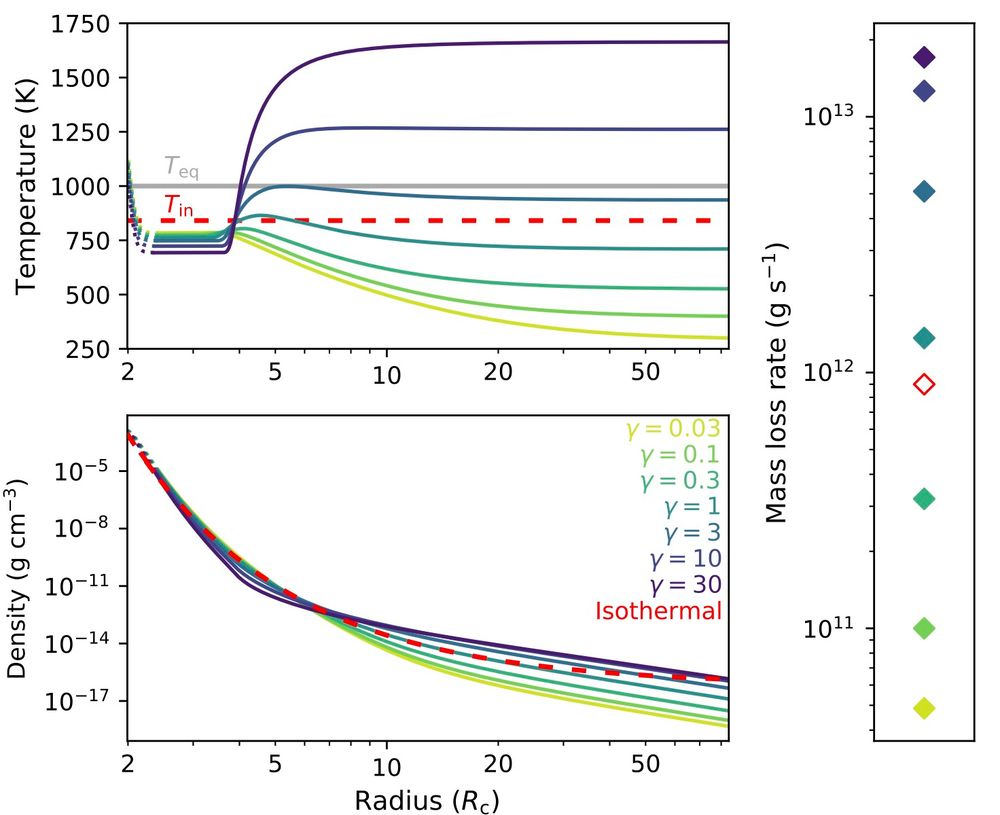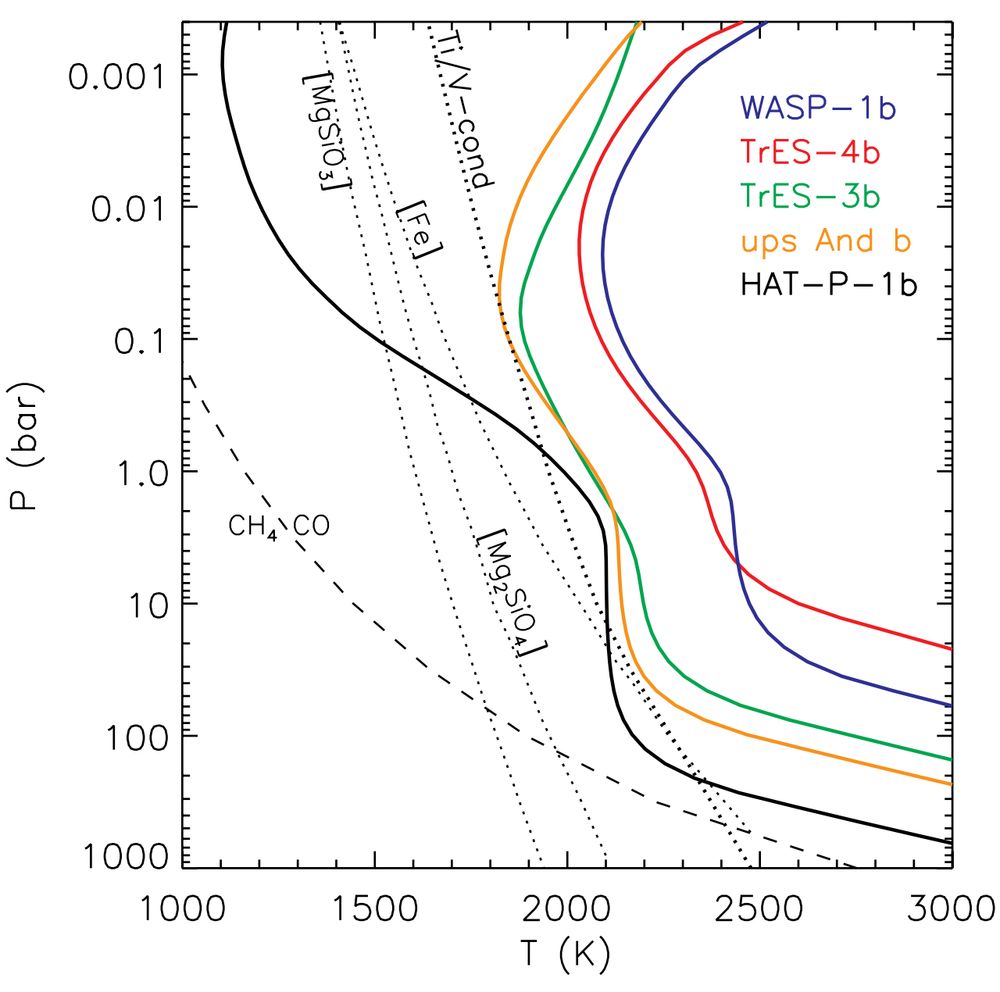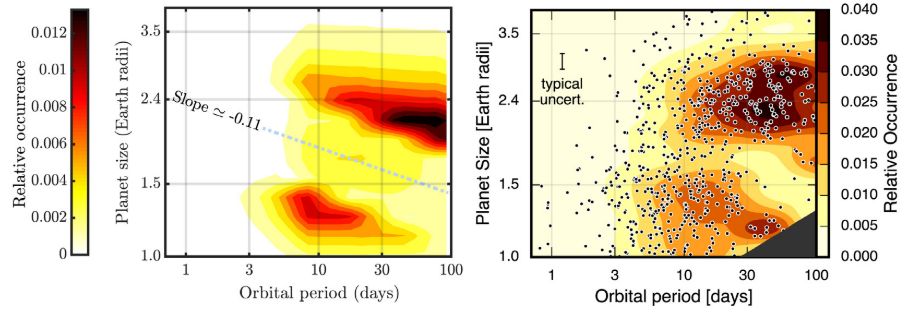
An illustration of a young planet with a surrounding disk of dust and gas potentially forming moons. The planet, which appears dark red, is shown at lower right, circled by a cloudy, clumpy reddish orange-colored disk. The host star appears at upper left, and glows yellow, with its own reddish disk of debris. The disk that surrounds the planet takes up about half the illustration. The black background of space is speckled with stars. At the bottom of the illustration, graphics of molecules are listed in the following order: Acetylene, Carbon Dioxide, Ethane, Benzene, Hydrogen cyanide. The words Artist’s Concept appear at upper right.
#NASAWebb has found the first direct evidence of potential moon formation around a giant exoplanet. The discovery is shedding light on how such systems evolve and why moons could be potentially habitable worlds: https://bit.ly/46xGodN 🔭 🧪
29.09.2025 14:03 — 👍 87 🔁 32 💬 1 📌 9

Three planeteers look through a mockup of a Curiosity rover wheel
The best part of my job is the people I get to work with 🪐💙
21.09.2025 01:57 — 👍 11 🔁 4 💬 0 📌 0
Tyler Rogers?
19.09.2025 14:01 — 👍 0 🔁 0 💬 1 📌 0
The advertisement for Carnegie EPL's 2026 postdoctoral fellowship is out! aas.org/jobregister/... We are also happy to host external fellowships like NHFP, NSF, and 51 Peg b (the latter is due Oct 3rd, one month away!). Please feel free to reach out if you have questions. (1/2)
04.09.2025 00:26 — 👍 5 🔁 4 💬 1 📌 1
I am a professional astronomy researcher
07.08.2025 12:33 — 👍 0 🔁 0 💬 1 📌 0
yes
06.08.2025 21:22 — 👍 0 🔁 0 💬 1 📌 0
@bot.astronomy.blue signup
06.08.2025 21:14 — 👍 0 🔁 0 💬 1 📌 0
Don't miss our new NASA Science spending and economic impact resource at dashboards.planetary.org/nasa-science.html — see space science spending in every state and congressional district and custom reports for each region. A unique resource.
02.06.2025 11:44 — 👍 158 🔁 88 💬 7 📌 21
It looks like Rutgers is sorted into NJ-12 (I'm not local, but from a map it looks like the district boundary goes through campus)
02.06.2025 12:33 — 👍 1 🔁 0 💬 1 📌 0
Still obsessed with maps and waiting for the smallest opportunity to foist it on to others 🚇🗺️
26.03.2025 19:39 — 👍 9 🔁 1 💬 0 📌 0
Do #exoplanets evolve over time? ☄️
A thread 1/🧵
17.03.2025 22:39 — 👍 74 🔁 16 💬 3 📌 3
Lastly: this research, and in fact most of my PhD salary and tuition, was funded by federal NASA grants. I'm deeply grateful for the opportunity these funds have provided me to advance our knowledge of the universe. I hope dearly we will continue to give aspiring scientists that same chance. 10/10
27.02.2025 23:20 — 👍 4 🔁 2 💬 1 📌 0
I'm looking forward to thinking about what prospective compositions lead to what escape rates, and how this effect interacts with photoevaporation, the other mechanism thought to play a role in shaping sub-Neptunes. Thoughts welcome! 9/10
27.02.2025 23:20 — 👍 1 🔁 0 💬 1 📌 0

Three panel plot showing RCB radius, atmospheric mass, and mass loss rate as functions of time. Different color curves represent different values of gamma. High values of gamma lead to large escape rates. Therefore most of the initial atmosphere is stripped within 1 billion years. Conversely, if gamma is low, virtually no primordial atmosphere is lost. Adapted from Misener et al. (2025), Fig 4.
That means that sub-Neptunes will evolve differently depending on the exact upper atmosphere composition, even if they're always hydrogen-dominated. We find that the opacity ratios can make a difference between very little atmosphere being retained under core-powered mass loss, or nearly all. 8/10
27.02.2025 23:20 — 👍 0 🔁 0 💬 1 📌 0

A plot showing mass loss rate as a function of radiative-convective boundary (RCB) radius. Different colors show different values of the opacity ratio gamma. Mass loss rate increases as a function of radius for all gamma values. But lower values of gamma lead to escape rates lower by 10 orders of magnitude at small radii than do high values of gamma. The rates converge at larger radii. Adapted from Misener et al. (2025), Fig 3.
The difference in mass loss rates for different opacity ratios is biggest when the atmospheres are most contracted, with up to a factor of 10^10 in mass loss rate separating cold upper atmospheres from hot ones! We provide tabulated rates in case you'd like to use these numbers yourself. 7/10
27.02.2025 23:20 — 👍 0 🔁 0 💬 1 📌 0

A three panel plot: on the left are temperature and density as functions of radius. Different colors represent different opacity ratios, quantified by gamma. On the right are mass loss rates corresponding to each profile. For small gamma, the upper atmospheres are cool, leading to low escape rates. For large gamma, the upper atmospheres are hot, leading to high escape rates. Adapted from Misener et al. (2025), Figure 2.
What we found is that the opacities have big implications for escape from sub-Neptunes: hotter temperature profiles lead to more mass loss! The most important reason why is that the density falls off more slowly if the temperatures are higher, leading to higher escape rates. 6/10
27.02.2025 23:20 — 👍 0 🔁 0 💬 1 📌 0
To account for this, we implemented core-powered mass loss in aiolos, a 1D hydrodynamic radiative transfer code, for the first time. This allowed us to calculate the escape rates and profiles self-consistently, and in doing so test the analytic approximations previous work had used. 5/10
27.02.2025 23:20 — 👍 0 🔁 0 💬 1 📌 0

Model P-T profiles of hot Jupiters from Fortney et al. (2008), showing prominent thermal inversions due to the presence of efficient optical absorbers (i.e., high gamma values in the upper atmosphere).
If the ratio (termed gamma) is near 1, then the atmosphere is roughly isothermal, but if it's not, you can get cool stratospheres or thermal inversions. This won't come as news to a lot of exoplaneteers, as we've long seen evidence for the phenomenon in atmospheric spectra! 4/10
27.02.2025 23:20 — 👍 0 🔁 0 💬 1 📌 0
But whether the outer atmosphere actually is isothermal depends on the actual opacities. More specifically, it depends on whether the atmosphere is more opaque to incident stellar light or to outgoing thermal infrared. These in turn depend on the actual composition of the atmosphere. 3/10
27.02.2025 23:20 — 👍 0 🔁 0 💬 1 📌 0

A two-panel plot showing the predictions of a core-powered mass loss model (left) against the observed planet demographics (right), showing good agreement. The mass loss rates in the models were calculated assuming an isothermal outer atmosphere. Adapted from Gupta+Schlichting 2019, Fig 2.
Core-powered mass loss, one of the mechanisms that can explain the radius valley separating the super-Earths and sub-Neptunes, has always been modeled using an analytic escape rate calculation, called a Parker wind, that assumed the outer atmosphere was isothermal at the equilibrium temperature 2/10
27.02.2025 23:20 — 👍 0 🔁 0 💬 1 📌 0
Blowin' in the Nonisothermal Wind: Core-powered Mass Loss with Hydrodynamic Radiative Transfer
The mass loss rates of planets undergoing core-powered escape are usually modeled using an isothermal Parker-type wind at the equilibrium temperature, T<SUB>eq</SUB>. However, the upper atmospheres of...
Apparently, between the switch to Bluesky and my defense and move, I've neglected to post about the last paper of my PhD. Now that it's been published in ApJ, here's a thread on how upper atmospheric opacities can alter escape rates and whether sub-Neptunes can retain primordial H/He 🔭🧪 1/10
27.02.2025 23:20 — 👍 9 🔁 1 💬 1 📌 0

The Carnegie Science sign on a snowy campus
Calling all undergrads! Just one week left to apply for Carnegie’s 2025 summer internship and work with us on all kinds of interdisciplinary projects in Earth & planetary science! Campus won’t look quite like this in June, but it’ll still be a magical experience ✨ carnegiescience.edu/about/workin...
24.01.2025 14:08 — 👍 9 🔁 7 💬 0 📌 0

Selfie with a AAS logo backdrop at AAS 243 in New Orleans
Excited for my first-ever (!) AAS this week. Look out for my thesis talk, conveniently on Monday morning to ease you back into conferencing:
133.05D “Coupled chemistry and structure of sub-Neptune atmospheres: a window into the interior”
Mon, Jan 8 10:40-11:00am
Room R04 #AAS243
07.01.2024 23:18 — 👍 12 🔁 0 💬 0 📌 0
Makes sense! It seems like the numbers might get really big quickly if there are a lot of false positives though (which I suppose doesn't really matter except for aesthetics lol).
01.10.2023 05:58 — 👍 0 🔁 0 💬 0 📌 0
What's been confusing/bothering me is, how come when the planets get confirmed, they stay as TOIs and don't become TESS-1 b or whatever, like how KOI-157.01 -> Kepler-11 c? Was there a reason for this? I guess it's fewer numbers to keep track of...
28.09.2023 22:52 — 👍 2 🔁 0 💬 1 📌 0
Astronomy PhD candidate at Indiana University. (Exo)planetary scientist. Runner. Average Android enjoyer.
Sharing the Japanese American experience. Look for programs near you at janm.org/OnTheGo
Postdoc @ MIT EAPS • Exoplanet Atmospheres • Habitability • Planet-Star Modeling
Postdoc MIT. PhD University of Amsterdam
I study the atmospheres of exoplanets. I am specifically interested in young transiting planets.
The people of the District of Columbia deserve dignity, respect, and self-determination. Join our movement to win it. #FreeDC
freedcproject.org
Find my blog at njudah.substack.com . I post about SF life, Muni and take photos. I don't post much here bc these kinds of sites kinda suck. Not affiliated with any agency or gov’t.
Physicist/planetary scientist/astrobiologist based at Harvard. Soccer dad in training. Social media native since 2024.
Climate & inequality journalist at Capital & Main.
Berkeley California Local News Fellow.
Lover of the Everglades, Venezuelan Jew & handwriting enthusiast.
Jlindenfeld@CapitalAndMain.com
California State Assemblymember | Los Angeles
Chronicling the happenings in Washington D.C.’s neighborhoods since 2006. Founder: Dan Silverman princeofpetworth@gmail.com
Your friendly neighborhood transit agency serving L.A. County. This is our official Bluesky account. We don't monitor this account 24/7.
I just want broad understanding that no one language is more valuable or valid than any other. That, and to always be close to a Trader Joe's. (she/her)
Tierras postdoctoral fellow at the Harvard Center for Astrophysics.
https://patricktamburo.github.io/
https://sites.harvard.edu/tierras-observatory/
This is the BlueSky feed of Raymond T. Pierrehumbert, Professor of Planetary Physics at the University of Oxford. Tune in for news about Principles of Planetary Climate, and diverse science and political commentary. (Also folk music news)
Doing the baseball things at @MLB dot com.
BBWAA. NYC. BU. NJ. Sometimes I play the bass. Go @njdevils.
Astronomy PhD, software engineer supporting space telescopes, and the astrophysics that they enable.
http://brettmorr.is/
Posts my own, not my employer's.
51 Pegasi b Fellow at Arizona State University and jazz enthusiast
The Carnegie Institution for Science is dedicated to scientific discovery and supporting exceptional individuals in an atmosphere of independence.
The mission of the American Astronomical Society is to enhance and share humanity’s scientific understanding of the universe as a diverse and inclusive astronomical community.
aas.org










